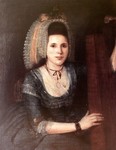Australia was so successful in producing some of the best wool in the world that for more than a century (1820s-1960s) its economy was highly depending on wool. If wool prices fell Australia went into recession. The notion of Australian prosperity is often expressed as ‘riding on the sheep’s back’.
In September 1795, the HMS Reliance entered Australian history. It was a discovery vessel of the Royal British Navy. She became famous as one of the ships with the early explorations of the Australian coast and other the southern Pacific islands.
Commanded by Henry Waterhouse, sailed to New South Wales, arriving in Sydney on 7 September 1795. Among her crew and passengers were Matthew Flinders as midshipman, George Bass as the ship’s doctor, the new Governor John Hunter, and the Aboriginal Bennelong.
The following year she later returned to Sydney, arriving from the Cape of Good Hope, carrying stores ordered by Governor Hunter.

At the Cape, Suzanne Nicolet Gordon, the widow of Colonel Robert Jacob Gordon, commander of the former Dutch garrison offered Waterhouse a flock of 26 merinos.
Gordon had been a Dutch explorer, soldier, artist, naturalist, and linguist of Scottish descent. He was responsible for the introduction of merino sheep at Cape of Good Hope in 1789. In 1795, his garrison was overrun by the British. They took possession of the Dutch colony of Cape of Good Hope. It ended the 150 years rule of the Dutch of the Cape. Gordon’s conduct in the battle was condoned and he was seen as a traitor by his compatriots. Consequently, he committed suicide, by putting a gun to his head, while sitting is his garden, he was 52 years old.
Suzanne wanted to sell the sheep before her departure back to the Netherlands. She offered her husband’s merino sheep to Waterhouse. However, the captain’s authority was to buy sheep for meat purpose only. She than offered them to him on personal title. Waterhouse entered partnership with Captain Kent of the HMS Supply and bought the sheep for 4 pounds each.
These 26 sheep and another three belonging to Captain William Patterson, as well as three that Suzanna gifted the Gidley King (who later replaced Hunter as the new governor of NSW) were loaded aboard the Reliance and the Supply for their journey to Australia.
Three purebred rams stayed in South Africa and were purchased by the Van Reenen brothers, friends of Colonel Gordon and among the most successful farmers at the Cape of that time. They formed the beginning of the successful merino wool production in that country.
Only 8 sheep survived the boat trip and were sold in Sydney, to Captain John MacArthur, Samuel Marsden, and Captain William Cox.
Interesting the sheep that ended up in Australia were the offspring of a merino flock originated from two rams and four ewes of the Spanish Royal Escorial flock They were, in 1789, given to the Dutch Government by King Charles IV of Spain in 1789 as a goodwill gift.
At the time the Netherlands was occupied by Napoleon, Spain was an ally of France and perhaps this relationship had something to do with the gift.
At this time, the Dutch were eager to improve the quality of their own wool and the sheep ended up in the Kempen, in the south of the Netherlands. However, the merinos did not like the damp climate of the Netherlands.
Later that year, the merinos were sent to the Dutch Colony at Cape of Good Hope, the climate here was much more suitable for these sheep. These six sheep were used for breeding at the Groenekloof experimental farm near Darling, north of the Cape. During 1791, Gordon received an official request from the Netherlands to return the Merinos because they should never have been sent to the Cape. He only returned the original number and kept the offspring. The road of history has many twists and turns.
Until the late 19th century the Spanish had maintained strict control of the export of merinos. The merino is one of the most historically relevant and economically influential breeds of sheep, much prized for its wool.
They most likely originated from Morocco as early as the 12th century, originating and being improved in Extremadura in southwestern Spain, in the 12th and 13th centuries or from the selective crossbreeding of Spanish ewes with imported rams at several different periods. It was instrumental in the economic development of 15th and 16th century Spain. The Crown held a monopoly on the trade in its wool, till the end of the 18th century.
In 1340 the Spanish King took possession of a unique flock originating in the North African Mahgreb to nurture on the Escorial plains north west of Madrid. In the sixteenth century the Spanish King Philip II built the El Escorial palace where he kept these sheep. Their fleeces of the royal Escorial flock soon became prized for being the finest and softest.
Since the arrival of the ‘Dutch’ merinos in Australia, MacArthur was able in 1804 to further purchase merinos from King George III of England, who had also received merinos from the Royal Escorial flock. Saxon Merinos which also originated from the Electoral flock were purchased in 1812.
Cross breeding developed distinct different Australian merino breeds. However, they are genetically similar and distinct from all other Merino populations around the world, indicating a common history after they arrived in Australia.
The Darling Downs west of Brisbane then became one of the largest sheep growing areas in Australia. It became known as the ‘jewel in the diadem of squatterdom’ with an elite ‘pure merino’ class living in comfortable houses
Paul Budde
Sources:
Australian Stockman’s Hall of Fame – Longreach
Merino – Wikipedia